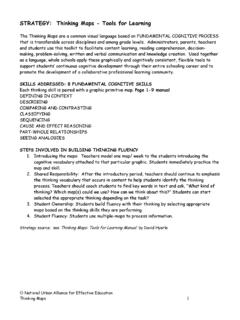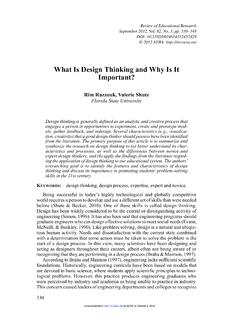Transcription of The Miniature Guide to Critical Thinking - Weebly
1 The Miniature Guide toThe Foundation for Critical 707-878-9100 Dr. Richard Paul and Dr. Linda ElderCritical ThinkingCo nC e p t s a n d to o l sClient:FCTP roject Title:Concepts/Tools Conf 2008 (07-069)Proof 5 Proof 6 Proof 7 Proof 812/3/07 11:35a12/3/07 12:40p12/3/07 3:20p12/4/07 1:15p Announcing the28th Annual International Conference on Critical ThinkingNear University of California at Berkeley July 19 24, 2008 Special edition Please join us for the28th Annual International Conference on Critical ThinkingNear University of California at BerkeleyJuly 19 24, 2008 For more than 25 years, the Foundation For Critical Thinking has emphasized the importance of teaching for Critical Thinking in a strong, rather than a weak, sense.
2 We are committed to a clear and substantive concept of Critical Thinking (rather than one that is ill-defined); a concept that interfaces well wwith the disciplines, that applies directly to the needs of everyday and professional life, that emphasizes the affective as well as the cognitive dimensions of thought. We advocate a concept of Critical Thinking that organizes instruction in every subject area at every educational level, around it, and on it, and through it. One implication of such an emphasis is this: that only through long-term planning can a substantive concept of Critical Thinking take root in instruction and learning.
3 We need short-term strategies, of course. But without long-term planning nothing substantial occurs. Deep learning does not 28th International Conference will focus on The Art of Teaching for Intellectual Engagement. Intellectually engaged students take ownership of content through actively Thinking it through, value questions more than answers, seek understanding over rote memorization. As an integral part of these processes, students learn how to learn, using disciplined reading, writing, speaking, and listening as modalities in learning. In the same spirit, all conference sessions will be interactive integrating reading, writing, and teaching as modes for internalizing the register, visit our website: call toll-free Miniature Guide to Critical Thinking Concepts and Tools 1 Fifth Edition 2008 Foundation for Critical Thinking Press Critical Thinking ?
4 2 The Elements of Thought 3A Checklist for Reasoning 4 Questions Using the Elements of Thought 6 Three Levels of Thought 7 Universal Intellectual Standards 8 Template for Analyzing the Logic of Articles and Textbooks 11 Criteria for Evaluating Reasoning 12 Essential Intellectual Traits 13 Three Kinds of Questions 16A Template for Problem-Solving 17 Analyzing and Assessing Research
5 18 What Critical Thinkers Routinely Do 19 Stages of Critical Thinking Development 20 The Problem of Egocentric Thinking 21 The Problem of Sociocentric Thinking 22 Envisioning Critical Societies 23 2008 Foundation for Critical Thinking Press The Miniature Guide to Critical Thinking Concepts and ToolsWhy Critical Thinking ?
6 The Problem:Everyone thinks; it is our nature to do so. But much of our Thinking , left to itself, is biased, distorted, partial, uninformed or down-right prejudiced. Yet the quality of our life and that of what we produce, make, or build depends precisely on the quality of our thought. Shoddy Thinking is costly, both in money and in quality of life. Excellence in thought, however, must be system -atically Definition: Critical Thinking is the art of analyzing and evaluating Thinking with a view to improving Result:A well cultivated Critical thinker: raises vital questions and problems, formulating them clearly and precisely; gathers and assesses relevant information, using abstract ideas to interpret it effectively; comes to well-reasoned conclusions and solutions, testing them against relevant criteria and standards.
7 Thinks openmindedly within alternative systems of thought, recognizing and assessing, as need be, their assumptions, implications, and practical consequences; and communicates effectively with others in figuring out solutions to complex Thinking is, in short, self-directed, self-disciplined, self-monitored, and self- corrective Thinking . It requires rigorous standards of excellence and mindful command of their use. It entails effective communication and problem solving abilities and a commitment to overcoming our native egocen-trism and sociocentrism. 2008 Foundation for Critical Thinking Press Miniature Guide to Critical Thinking Concepts and Tools 3 The Elements of ThoughtPoint of Viewframes of reference,perspectives,orientationsPurpo segoals, objectivesQuestion at issueproblem, issueImplications and ConsequencesAssumptionspresuppositions, axioms, taking for grantedInformationdata, facts, observations, experiencesInterpretation and Inferenceconclusions, solutionsConceptstheories, definitions, laws, principles.
8 ModelsElementsofThought Used With Sensitivity to Universal Intellectual StandardsClarity Accuracy Depth Breadth Significance Precision Relevance 2008 Foundation for Critical Thinking Press The Miniature Guide to Critical Thinking Concepts and ToolsA Checklist for Reasoning1) All reasoning has a PURPOSE. State your purpose clearly. Distinguish your purpose from related purposes. Check periodically to be sure you are still on target. Choose significant and realistic ) All reasoning is an attempt to FIGURE something out, to settle some QUESTION, solve some PROBLEM.
9 State the question at issue clearly and precisely. Express the question in several ways to clarify its meaning and scope. Break the question into sub-questions. Distinguish questions that have definitive answers from those that are a matter of opinion and from those that require consideration of multiple ) All reasoning is based on ASSUMPTIONS. Clearly identify your assumptions and determine whether they are justifiable. Consider how your assumptions are shaping your point of ) All reasoning is done from some POINT OF VIEW. Identify your point of view.
10 Seek other points of view and identify their strengths as well as weaknesses. Strive to be fairminded in evaluating all points of view. 2008 Foundation for Critical Thinking Press Miniature Guide to Critical Thinking Concepts and Tools 55) All reasoning is based on DATA, INFORMATION and EVIDENCE. Restrict your claims to those supported by the data you have. Search for information that opposes your position as well as information that supports it. Make sure that all information used is clear, accurate, and relevant to the question at issue. Make sure you have gathered sufficient ) All reasoning is expressed through, and shaped by, CONCEPTS and IDEAS.



